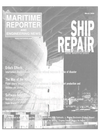
JAMSTEC Deepsea Exploring Ship Contract Announced
Japan Marine Science and Technology Center (JAMSTEC) will build a deep sea exploring ship for the Integrated Ocean Drilling Program (IODP) and has signed a contract with Mitsubishi Heavy Industries, Ltd.
(MHI) for the basic design of the deep sea exploring ship and with Mitsui Engineering & Shipbuilding Co., Ltd. (MES) for the dynamic positioning system (DPS) and ship systems. IODP is an international program carried out by the U.S., Japan, and other participating nations. The program targets studies on the earth and life science through exploring changes in weather, mechanisms of change deep in the earth, unknown living organisms in deep seas, and gas hydrates. The ship must be operated in sea areas with water depths of 8,202 ft.
(2,500 m) and 13,123 (4,000 m) (in the future) and be capable of drilling deeply to the mantle.
The contract for construction of the ship is being drawn up this month, and the ship will be completed in 2004. TSC completes DH tanker Pacific Libra Tsuneishi Shipbuilding Co., Ltd.
(TSC) has corn- pleted construction of the Pacific Libra, a double-hull Aframax tanker of 106,644 dwt, for Pacific Lily Shipping S. A. of Panama. The new tanker is designed for increased propulsion efficiency. A newly-designed propeller can achieve 15 knots in service speed with an engine output less than that required for the conventional Aframax tanker. The Cu-Fe type anti-adhesion system against marine organisms is installed to prevent adhesion of marine organisms to the hull, as well as hull corrosion. Cargo oil tanks consist of six pairs of tanks and one pair of slop tank (14 tanks), which are separated by the center bulkhead. The total cargo oil tank capacity is 119,055 cu. m. (98 percent), or approximately 748,828 barrels. The OCIMF (Oil Companies International Marine Forum) Ship to Ship Transfer Guide is used to allow cargo handling with other ships.
Three types of oil cargoes can be carried at the same time, and double valves installed on cargo lines prevent contamination between cargoes. Three cargo oil pumps with a capacity of 2,500 cu. m. /hr x 135 T.H. are installed.
Automation of the engine room complies with M0 requirements. The seawater cooling pipes for the main engine is lined with polyethylene to protect the pipes from corrosion. Auxiliary boilers can burn A-type heavy fuel oil for preservation of the environment.
Other stories from March 2000 issue
Content
- A broader-based payback from R&D page: 8
- An Effective Shield from Criminal Prosecution page: 14
- MARCO Signs Contract With S.F. Bar Pilots page: 16
- MAN Acquires Alstom Diesel Engine Ops page: 16
- South Korean January Ship Orders Increase page: 17
- Dockwise Awarded Hanjung Contract page: 17
- The U.S. Navy - Reducing Shipboard Planned Maintenance page: 20
- Safety Charter Targets Old Tankers, Flags Of Convenience page: 20
- High Times Again in Singapore? page: 22
- Ship Repair Yards Ask: Where's the Funding? page: 26
- Ailsa-Troon Continues To Climb page: 27
- Irving Shipbuilding Repairs Wide Selection page: 29
- Vessels Make Pit Stop At Bay Ship page: 30
- Tampa Bay Shipbuilding - Gearing Up For A Boom page: 31
- Bollinger Puts Its Expertise To The Test page: 32
- Turbo-Technik: Rescuing A "Prinsesse" page: 33
- Smooth Sailing page: 34
- Seacoast Delivers Package To Halter page: 34
- JRC Radar Offers Plotter System page: 34
- SKYbolt Enables Real Time Processing page: 38
- Transas Moves Towards Auto Integrated Navigation page: 44
- Litton To Supply For New Passenger Ferries page: 44
- Riverboat Casino Ratings Buoyed by Regulations, Demand page: 48
- Washburn & Doughty: Developing New Process To Meet Changing Needs page: 49
- Fictitious Tugboat Character Goes Live In Canada Yard page: 51
- Bollinger opts for Oracle page: 52
- BIMCO Introduces Millennium Software page: 55
- Ship Safety Database Set Up To Avoid Future Disasters page: 55
- WindShip Technology Promises Fuel Saving s page: 56
- Recore Classified As Fireproof For Vessels page: 56
- Sandwiched Composites Offer Promise For Marine Industry page: 57
- Fiberline Offers GRP For Use In Hostile Environs page: 57
- AMT Marine To Construct Utility Boat page: 59
- Sneed Delivers Pushboat To Blessey Marine page: 59
- Alert in Valdez Harbor page: 60
- 3.MAJ Delivers Innovative Tanker page: 61
- Robert Allan Design To Be Built For Brusco page: 62
- New Surface Cleaning Process Saves Navy On Maintenance page: 65
- Jotun Goes Tin-Free page: 66
- Se-Cliff Enhances With CoreKote 2000 page: 69
- Japan: Advanced procedures sustain industry in turbulent markets page: 74
- JAMSTEC Deepsea Exploring Ship Contract Announced page: 75
- Power management with distributed intelligence page: 76
- Chamber Of Shipping Requests Entries page: 77
- The Erika oil spill - using the incident to positive effect page: 80
- NCL Board Dumped, Lund Appointed page: 92
- Litton Integrates Marine Ops In New Company page: 92

